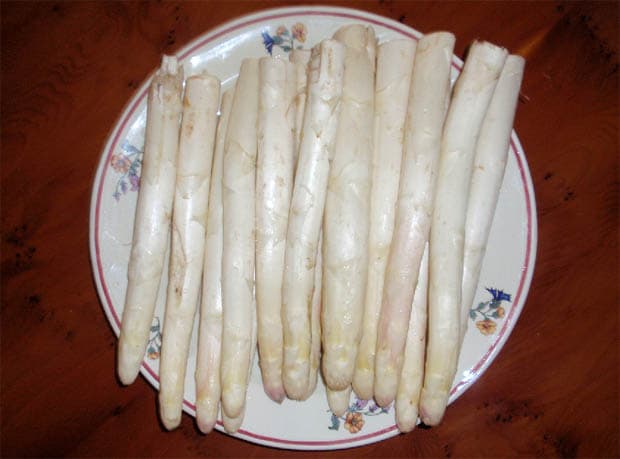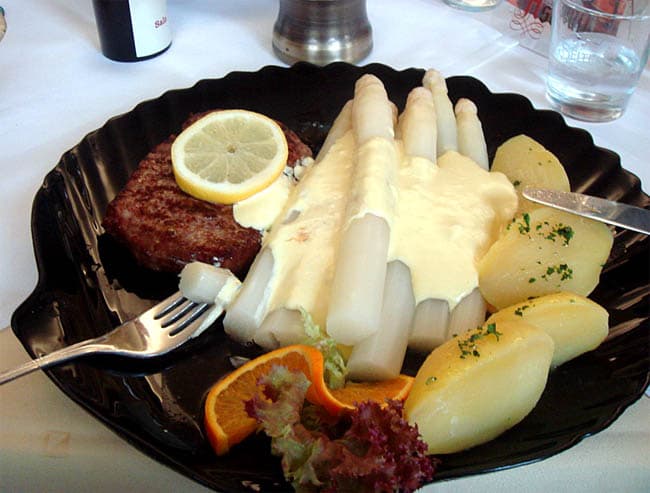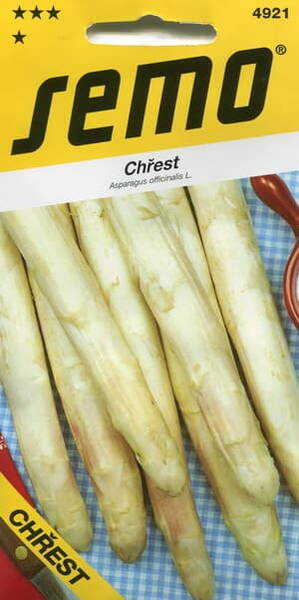Asparagus makes high demands on soil conditions. It requires well-aerated soils with highly permeable subsoil.
The best for asparagus is light sandy, sandy or loamy soils with a deep arable horizon.
Heavy soils can cause the deformation of young shoots, and their curvature and such shoots are already non-standard products.
Asparagus can also be grown in drained peatlands. But asparagus does not tolerate high acidity.
Soils with a pH of 6.5-7.0 are optimal for it. Already on slightly acidic soils, lime is required for asparagus.
1 gram = 50 seeds.

Asparagus "Argenteuil" is a French Heirloom Asparagus developed from an 18th-century asparagus variety known as Purple Dutch at Argenteuil, France between 1860 and 1862.
Argenteuil was one of the earliest varieties to exhibit the large asparagus spears so well known today. Argenteuil is a traditional French asparagus variety used to create the popular "white asparagus" in France through means of blanching the plants. When un-blanched, this asparagus variety produces thick, rose-purple with excellent flavour and tender tips. Argenteuil Asparagus is earlier than most asparagus varieties and should be sown by seed from mid-March to the end of June. Unlike many other asparagus varieties which do not offer a decent harvest until the third year, Argenteuil will give a good yield in the second year.

Asparagus is a relatively salt-tolerant plant. Plants thrive best in well-drained areas.
The site should be well-drained and free of perennial weeds and protected from cold winds.
Place the asparagus out of the rotation. For the placement of asparagus, the best are considered adjacent areas near greenhouses, near nurseries, that is, land with a rich layer of humus.
In other areas, high doses of organic fertilizers are needed.
Asparagus is grown by seedlings or by planting individual parts of the rhizome. Seedlings are grown in special open nurseries on highly fertile soils; beds well fertilized with humus are used in garden plots.
Sowing is carried out in late May - early June. 8-10 days before sowing, the seeds are soaked for 3-5 days in warm water or a weak solution of potassium permanganate (+30+35°C), which is changed several times.
Then they are scattered on a damp burlap and placed in a warm place (+ 25 ° C), making sure that they do not dry out.
After 6-8 days, the seeds peck, and they are sown on the beds. Sowing depth is 2-4 cm, the distance between rows is 15-20 cm, and the distance between plants in rows is 3-5 cm.
After germination, thinning is carried out, leaving 15-20 cm between plants.
Seedling care in the first year consists of weeding, 2-3 loosening of row spacings, top dressing with full mineral fertilizer (10-15 g / m), as well as a slurry (1:6) or bird droppings (1:20) 1-2 times per season. The consumption of liquid fertilizers is 0.2-0.3 l per 1 running meter.
By the autumn of the first year of life, the seedlings have 2-3 stems. For better overwintering, seedlings are covered with a layer of peat or humus 5-8 cm thick.
They are planted in a permanent place either in the spring of next year before the shoots started to grow or in August.
Sometimes the nursery is left for the third year and the flowering plants are culled, in this case, only male plants are planted.
Care for seedlings in the second or third year of life consists of top dressing, weeding and loosening of row spacing.
Properly grown seedlings should be 20-30 cm high and have at least 5 stems with dense, well-developed buds and a powerful root system; dig it up, being careful not to damage the roots.
The site is prepared in advance and carefully, as it has been used for many years. Before planting asparagus, the soil is fertilized in autumn, based on 1 m2: 10-30 kg of organic fertilizers, 30-40 g of superphosphate and 20-30 g of potassium chloride; close up fertilizers by 25-30 cm, digging the earth onto a shovel bayonet.
In the spring, the site is again dug up or loosened.
Seedlings are planted in spring or late summer - autumn. The best planting dates are from May 1 to May 15 (before the shoots grow back), as well as the second half of August.
Before planting, furrows 35-40 cm wide and 25-40 cm deep are dug in the prepared area. The distance between the furrows is 1-1.2 m, they are located from north to south.
On the loosened bottom of the furrow, rotted manure or compost (15-20 cm thick) is laid and a low ridge is made at the bottom.
It is better to plant seedlings on a cloudy, rainy day. Before planting, the soil is well shed and seedlings are planted, carefully spreading the roots along the slope of the ridge and sprinkling them with a layer of soil (5 cm thick). One row of plants is placed in each furrow and the distance between plants in a row is 30-40 cm. After planting, the plants are watered.
When laying a plantation for food purposes, from two-year-old seedlings, they prefer to plant more male and fewer female specimens.
Seedlings are selected on which berries have not formed, that is, male plants. They are more productive and durable than women.
Selected plants for the winter are added dropwise and planted in early spring before they start growing.
When caring for asparagus, it is necessary to carry out light loosening of the soil (deep roots can be damaged close to the surface), manual weeding and 2-4 times watering during the season as needed, depending on the weather.
In the first year, a layer of humus is increased by 10-15 cm, in the fall the yellowed leaves are cut off and the plants are spudded.
In the second year after planting, in the spring, soiling is carried out (the soil is raked from the plants) and a layer of humus is built up above the rhizome, bringing it up to 25 cm.
At the beginning of the growing season, top dressing is carried out with complete mineral fertilizer (20 g / m3). In subsequent years, mineral dressing is carried out twice: half of the fertilizer (10 g / m 2) is applied in the spring and the rest - immediately after cutting the shoots. After 3-4 years, manure is introduced into the row-spacing at the rate of 5-6 kg/m2.
Since the first 2 years of asparagus shade the aisles little, they grow onions, carrots, early cabbage, lettuce and other compact crops.
It is possible to carry out forcing asparagus in a greenhouse (in winter) and a greenhouse (early spring), to get early production using temporary film shelters.
In winter, fresh asparagus can be obtained even from the open ground by raking snow from the plantation and heating the soil with hot manure.

HARVEST.
Cutting shoots begins only in the third year after planting seedlings in a permanent place.
Prior to this, the shoots are not cut, because in order to ensure high yields, plants must form powerful rhizomes with a large supply of nutrients in the first 2 seasons.
For distillation and cutting of bleached shoots, plants are spudded in spring to a height of up to 20-25 cm.
Harvesting starts in May. To obtain products at an earlier date, the plants can be covered with a film and laid with warm manure.
The readiness of the shoots for harvesting is determined by the cracks that form the soil surface.
When harvesting, the earth around the plant is carefully raked to the base of the shoot and cut off with a special knife (you can also use an ordinary, well-sharpened one) 3-4 cm above the root collar, and the hole is again covered with humus or peat compost. Harvesting is carried out in the morning or in the evening every 1-2 days - on 3-year-old plantations for 20 days, and starting from the 4th year and later, the cutting period is increased to 30-40 days.
In the first year of harvesting, 4-5 shoots are cut from each plant, in subsequent years - up to 15-30 shoots with a total weight of up to 1.8 kg.
After the end of the harvest (end of June), the plants are uncovered and allowed to grow in order to accumulate a sufficient amount of plastic substances for overwintering and the formation of shoots next year.
The method of growing green asparagus has also become widespread.
The agrotechnics of such asparagus is simpler, harvesting is less time-consuming, and the shoots are not inferior in quality to bleached ones.
When growing green asparagus, the plants are not spudded, and the shoots are cut when they reach a height of 15-18 cm below the soil level by 2 cm, with unblown dense heads (these undeveloped, brittle, tender shoots are more valuable and tastier than bleached ones).
For etiolation of shoots without hilling, you can use a black film or other opaque material. In autumn, yellowed above-ground shoots are cut and burned.
During the growing season, they receive 2.0-2.5 kg/m2 in the first years, and up to 4-6 kg/m2 of asparagus in subsequent years.
Asparagus shoots should be sold and used immediately after harvest, because. they quickly wither and lose their presentation.
To keep cut asparagus for several days, wrap it in a damp cloth and put it in the refrigerator. You can also store asparagus shoots for a short time in a cold, dark room at a temperature of +1 ° C (it is recommended to lay them in clean, moist river sand in a vertical position, since they quickly bend when laid horizontally).
Standard fresh shoots of asparagus should be whole, healthy, unpolluted, with unopened and unbranched heads, with the color characteristic of the botanical variety, juicy, not hollow, not woody, 12 to 25 cm long, at least 1 cm thick.
Culinary processing of asparagus.
Fresh asparagus needs almost no processing - you can only remove the thin top layer with a knife if it is fibrous, but usually (if the shoots were cut on time) this is not required. The shoots are tied up in 8-10 pieces and boiled for 5-10 minutes in salted water (you can add a little sugar - the aroma will become more intense) but do not digest, otherwise their taste noticeably deteriorates. It is better to lower the boiled asparagus into the water with ice (then it retains its colour and will be even tastier), and then throw it into a colander.
Keep in mind that the lower part of the asparagus shoot is cooked longer than the crown (the latter generally needs to be steamed, not in water), so it used to be cooked in a special pan that allowed the shoots to be placed vertically. Choose the narrowest pot, place something like a round frame or wire basket inside, and arrange the bundles so that the tassels are above the surface of the water.
Soups, side dishes and even desserts are prepared from asparagus. But real gourmets use it in its pure form - after cooking, sprinkle with breadcrumbs or semolina and lightly fry in olive or butter, or eat with sauce.
The classic sauce for asparagus is prepared as follows: 3 yolks are heated on a steam bath with continuous stirring, and then 150 g of melted butter is poured in a thin stream. Add 1 teaspoon of lemon juice and salt and, without ceasing to stir, remove from heat. A simpler version of the sauce is also possible - sour cream is mixed with crushed garlic and herbs.












